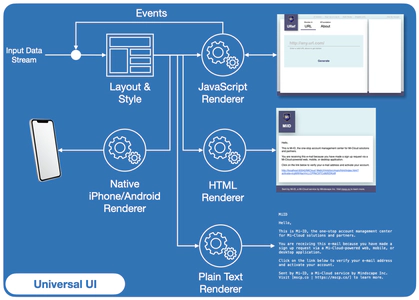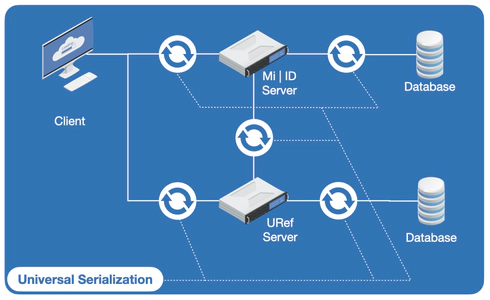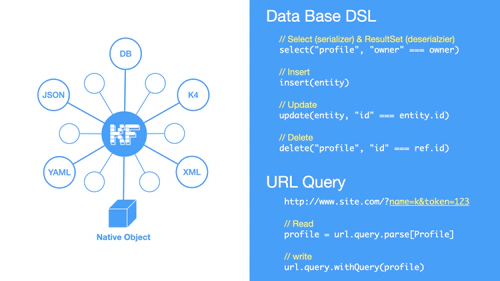Universal UI
Universal UI is the world first Omni-Media interactive content development platform. This technology is enabled by Content and Flow APIs that allow dynamic contents to be designed for any arbitrary target media, and cross-platform compilation technology that allows the solution to be ported on any desired device.

UUI Framework
Universal UI framework consists of two major components:
- Content DSL – A domain-specific language that can be used to compose layouts, graphical, and textual content for any device. Conceptually, it is very similar to HTML+CSS.
- Flow API – An asynchronous reactive way of adding dynamic behavior to content and handing events.

Comparison
Universal UI is the leads the industry in portability. Here how it fairs against competing technologies such as Google Flutter, React and Vue.js.

Universal Serialization
Universal Serialization is the Universal UI for machine-to-machine interaction. Every interaction your app make with servers, is supported and can be done using Universal Serialization.

Read and write data as object models, to and from virtually any target format. It supports Postgres database, JSON, YAML, XML, and KFoundations’s own K4 format. It can even convert URL query strings back and forth to objects.
Universal Serialization is supplemented with a SQL-like DSL that acts like ORM (Object Relational Mapping). It constructs relevant select, insert, update, and delete queries and send them to database server. Then, it uses that knowledge to transform the result-set returned from the server back into entity object models.

Universal Culture

The core feature of Universal Culture is the introduction of advanced dictionaries that can formulate translation of parameterized strings, dates and numbers into any given target language. Moreover, these dictionaries are supported by Universal Serializations framework, which means that they can be supplied in any format including, K4, JSON, XML, YAML, or programmatically.
Specially in case of number, time and date formats, UC’s advanced dictionaries can be supplied and used as libraries to be included and used alongside user-defined dictionaries.
These are example of what Universal Culture can localize.
<Strings>
HELLO (en) -> Hello
(fa) -> سلام
(ja) -> こんにちは
<Numbers>
(en) -> 123.456
(fa) -> ۱۲۳/۴۵۶
(en/read) -> one thousand and two hundred thirty four
(en/order)-> one thousand and two hundred thirty fourth
(fa/read) -> هزار و دویست و سی و چهار
(ja/read) -> 千二百三十四
<Julian Calendar>
(en/short) -> 11/02/81
(en/long) -> Monday, November 2, 1981 CE
(en/longer) -> Monday, second of November, one thousand and nine hundred eighty one CE
(ja/simple) -> 1981-11-2
(ja/short) -> 西1981年11月2日
(ja/long) -> 西暦1981年11月02日(月)
(ja/longer) -> 月曜日 西暦千九百八十一年十一月二日
<Japanese Calendar>
(ja/short) -> 平5年11月2日
(ja/long) -> 平成5年11月02日(火)
(ja/longer) -> 火曜日 平成五年十一月二日
<Jalali (Persian) Calendar>
(fa/short) -> ۷۷/۰۳/۱۲
(fa/long) -> چهار شنبه ۱۲ خرداد ۱۳۷۷ ه.ش.
(fa/longer) -> چهار شنبه دوازدهم خرداد هزار و سیصد و هفتاد و هفت هجریِ شمسی
(en/short) -> 03/12/77
(en/long) -> Wednesday, Khordad 12, 1377 AH
(en/longer) -> Wednesday, twelveth of Khordad, one thousand and tree hundred seventy seven AH
Universal More!
Universal Web Client
Our ultimate goal is to bring the same fluid and efficient APIs to every platform. That couldn’t be more true about the WebClient API. It works on all possible Scala targets including JVM, JavaScript and Android, having a tailored implementations for one each of these underneath. Integration of WebClient with Universal Serialization and StreamWriter APIs makes it the most fluent and versatile RESTful client out there.
Usage Example:
client.request(URL("http://...")) //: WebClient.RequestBuilder
.withHeader("header", "value") //: WebClient.RequestBuilder
.get //: Future[WebClient.Response]
.foreach(r => STD_OUT.writeAll(r.body))
Universal Validation
We offer a novel and rich functional validation framework that ensures the data that is being passed around always fits its contract. It comes with a DSL to define the contracts, and applying them to data. Further more, when it is safe, it can convert data from one form to another. Validation errors thrown by the validation framework are compatible with both Universal Serialization and Universal Culture. They can be passed from server to client, and from client to end user, while being translated to human readable messages in user’s language of choice.
Usage Example:
val passwordRule = AllOf(
Property.ustringLength(InRange from 8 128),
Contains.UPPERCASE,
Contains.LOWERCASE,
Contains.anyChar('%', '$', '%', '&', '^'),
Not(Contains.anyString("123", "abc")))
K4 Language
K4 is a machine- and human-readable marked up language that fixes lack of type-safety in JSON, and bulkiness of XML. Example:
MultiDictionary[default="en-US"
fallbacks={
Fallback[from="zh-HANT" to="zh-HANS"]}
domains={
Domain[name="co.mscp.uref.webui" entries = {
EntrySet[key="LOGIN_HINT" values={
Entry[lang="en-US" value="Hint: Login to create fancy urls.”]}]}]}]
LoTeX Language
LoTeX is a typesetting language inspired by LaTeX, retaining the simplicity but fixing grammar ambiguity of Markdown. Example:
This web application is a demonstration of various technologies in \b{KFoundation} software platform. KFoundation is an open-source project development and maintained by Mindscape Inc.
\list{
\* Localization is provided by \b{Universal Culture} - one the mostcomplete and advanced localization toolsets.
\* Interaction between client and web server, and between web server and database server is enabled by \b{Universal Serialization}.
\}
KnoRBA Project
Recursively built on KnoRBA itself with its only other dependency being KFoundation POSIX Edition, it is an attempt to create a new unifying and universal operating system based on a new programming paradigm, called Agent-Based Computing (inspired by Minskey’s ideas, and comparable to Hewitt’s Actor).
KnoRBA is distributed and parallel in its very core. It can operate dynamically changing clusters of devices as a single fault-tolerant integrated system in a decentralized fashion. The resulting system can be a supercomputer, a car, or a smart home. Current prototype is made of a runtime environment (ARE) that does distributed process management and interprocess communication (IPC), as well as a C++ library for building KnoRBA Apps (KAP).
